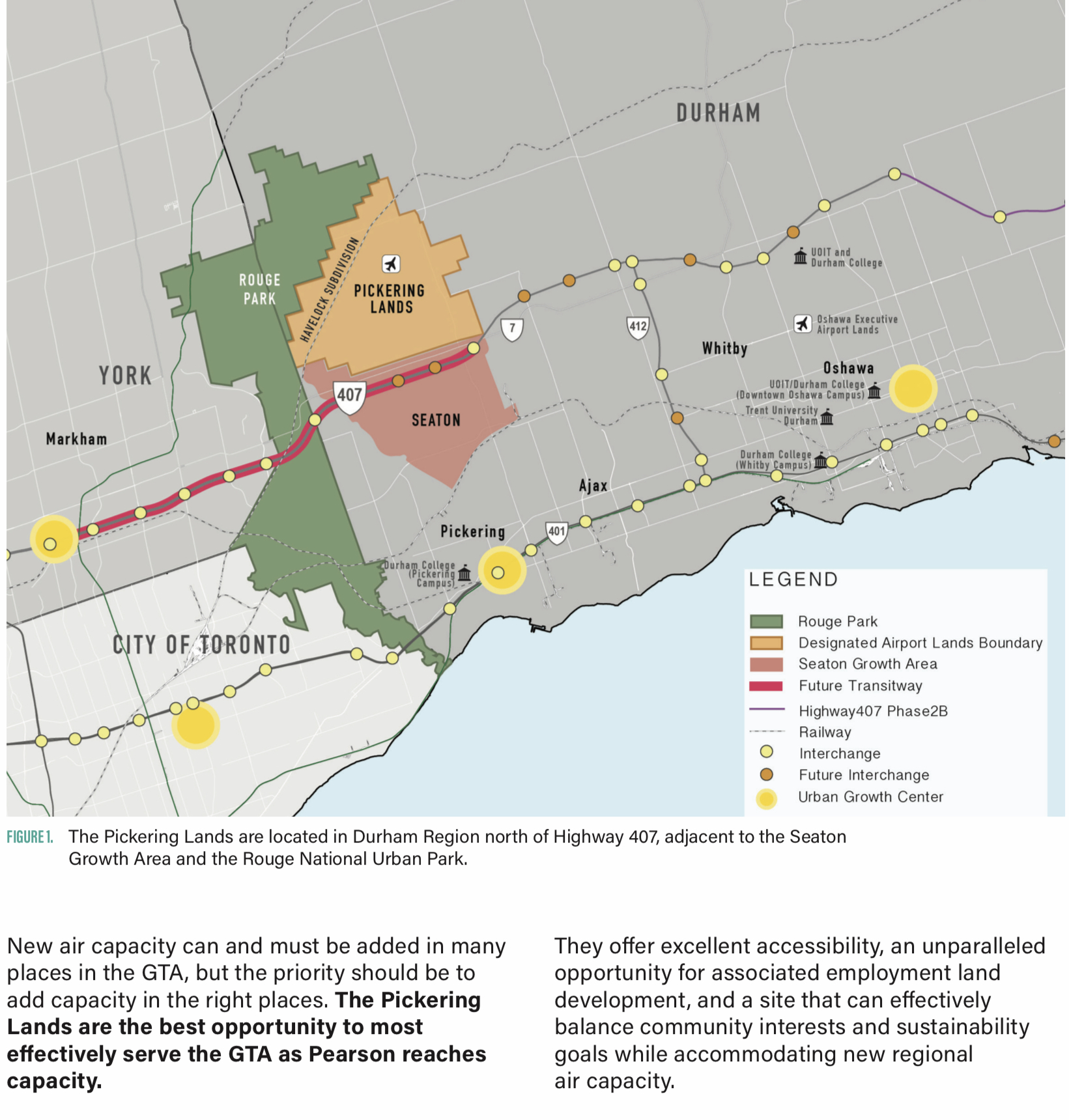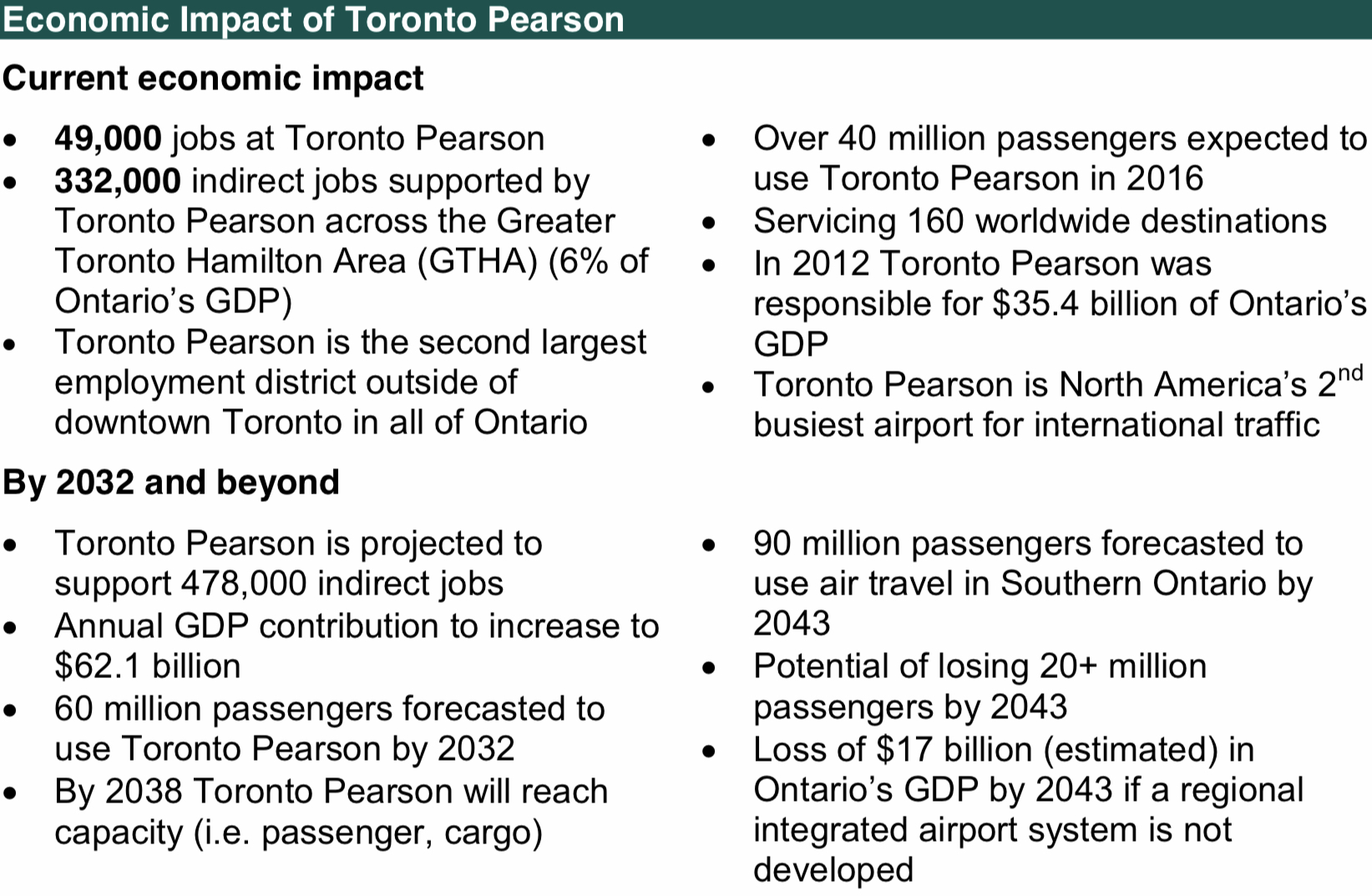With the recent announcement of the closing of the City of Oshawa’s largest employer, the General Motors assembly plant, what does the future hold for aviation in Oshawa and the eastern Toronto region? Airport areas are catalysts for employment clusters that generate jobs and GDP for the surrounding region.

For 60 years, the eastern Toronto region has had two active, publicly accessible airports. One in Markham (privately-owned Buttonville Airport) and the other in Oshawa (owned and operated by the City of Oshawa). Designed before the jet age, both airports are small, with runway lengths too short to accommodate modern passenger jets. Although important creators of economic activity, both have small footprints. Today they handle general aviation including flight training and executive jet traffic. Both are landlocked (surrounded) by noise sensitive communities. Neither airport could expand to handle the growing need for passenger jet traffic, nor the associated business activity.
To solve this bottleneck, improve aviation accessibility, capacity, and to keep up with the Toronto aviation sector’s growing demand, a new, much larger airport in Pickering is being planned. The new airport will be built halfway between the two existing airports on land set aside for this purpose more than 45 years ago by farsighted planners at Transport Canada.
The new Pickering airport is expected to create thousands of new jobs, more jobs than are being lost within the auto sector. Toronto Pearson airport is an excellent example. The cluster of 300,000 jobs around the Pearson airport makes it the second largest employment area in Canada after downtown Toronto. This kind of ‘aerotropolis’ is the promise of the new Pickering airport to be build in Durham region.

For many, the time has come for the Durham region to take control of its future. It is time to build Pickering Airport. But what does the future hold for Oshawa Airport and the privately-owned Buttonville Airport when the new Pickering Airport opens? The answer is dependent on profitability and politics.
Buttonville Airport is said to be profitable, but will it remain so? Oshawa Airport is losing money and has an added burden of being at the mercy of city politicians, so will it survive the electoral process? How will the recent announcement of the closing of the city of Oshawa’s largest employer, the General Motors assembly plant, effect the timeline of the construction of Pickering airport and the closing of Oshawa and Buttonville airports?
Back in 2015, The City of Oshawa (which owns Oshawa Airport) described a bright future for its airport despite its small size and physical limitations. The plan was to focus on the growing executive aviation market place and to shrink its deficit from $472,000 in 2015 to $167,000 in 2019 and break even after that. Surprisingly, the city’s plan expected a doubling of traffic at its airport in just five years, while maintaining a flight training cap of 60,000 movements.
This planned growth, from 51,000 movements in 2014 to 102,000 by 2019 was projected to be achieved mostly on the back of traffic that would shift when eastern Toronto’s other key general aviation airport, Buttonville, closed. At this point Oshawa then expected to carry the load until Pickering airport opened.
Fast forward to the end of 2018, Oshawa has fallen far short of its planned targets. The reason is that Buttonville airport remains open and its private owner continues to invest in maintaining its infrastructure. Buttonville’s owners have no immediate plans to close the airport and have confirmed that it will remain open for at least another five years, possibly 10. If Buttonville is profitable it could stay open indefinitely.
But what happens when a new modern jet airport with safer, longer runways, room to buildout modern hangars, a stylish terminal, and maintenance infrastructure opens in Pickering? Years ago, when the City of Oshawa purchased its airport from the federal government for only $1.00, it did so under the condition that it keep the airport open until 2047. But there is a caveat in the agreement that allows the city to close its airport once the nearby Pickering Airport opens (expected as early as 2028).
Oshawa understands its airport’s lifespan is limited. To alleviate the fears of local businesses, in 2008, council passed a resolution committing the City to operate the airport until 2033. In theory this should provide several years for aviation businesses to transition over to the new Pickering Airport. But do the Oshawa or Buttonville airports need to close when the Pickering Airport opens?
There doesn’t appear to be a technical reason for the closure. Although the Oshawa’s airport location is inline with runway 28 at the proposed Pickering Airport, it is more than 20 km from the new airport. Aircraft going into, or out of, the new airport will either not overfly Oshawa Airport, or if they do, they will be at 3,500 ft or higher. This will provide plenty of safety margin to continue operating both airports simultaneously. An example of a similar situation exists today at Buttonville airport, which is overflown by traffic landing on runway 23 at Toronto’s Lester B. Pearson International Airport. The only reasons to close Oshawa Airport are due to future development opportunities, costs, and politics.
Buttonville Airport is in a similar situation, and could continue to operate after Pickering Airport opens, if its private owners wished, assuming it remains profitable. Given the demand for flight training, general aviation (GA), and executive aviation services and Buttonville Airport’s lean management style, this is possible.
Pickering Airport is being planned as a larger regional jet airport set to open as early as 2028. GA traffic is part of the plan, but growing jet traffic is expected to dominate the new airport. Therefore, Oshawa and Buttonville airports, despite short runways and other imperfections, can continue to play an important role by enhancing the region’s general and executive aviation capacity. But will they?
Privately-owned Buttonville Airport’s conditional sale to developers in 2011, to build a high-end shopping mall complex, sparked the first privately funded proposals to build Pickering Airport. But after Buttonville Airport began winding down traffic and prepping to close, changing business conditions including the rise of online shopping and development costs have placed its closure on hold. Buttonville Airport is still expected to close at some point, but not until a profitable deal for redeveloping the land can be struck.
Buttonville Airport has no political master to answer to and has been profitable for decades, but unfortunately Oshawa Airport cannot say the same. Oshawa Airport’s balance sheet is less sustainable and there will be both political and financial pressure on the airport to close once Pickering Airport opens. Closing the Oshawa Airport and selling the land would be a one-time financial windfall for local taxpayers. It could also enable the City to repurpose the airport lands to uses that generate more longer-term tax revenue. It could provide a political opportunity to reduce both liability and aircraft noise over the city thereby reducing contention. Residents of a nearby subdivision have been complaining about noise pollution from Oshawa Airport for years.
So, it is possible that the City of Oshawa could use the opening of Pickering Airport as a trigger to close its airport unless it is given a compelling reason not to.

This will mean that existing Oshawa businesses and traffic will need to migrate to Pickering Airport. Pickering Airport’s plan must make allowances for this, as well as for Buttonville Airport’s aviation traffic, if the need arises. It also raises the strange spectacle of Oshawa Airport closing while Buttonville Airport is still open. Under these conditions at least some of Oshawa Airport’s displaced traffic could move to Buttonville Airport instead of to the new Pickering Airport. This is the reverse of what has been expected to happen for years.
Oshawa Airport should not be expecting displaced traffic from a Buttonville Airport to magically bump its traffic numbers and solve its problems. Instead, it needs to focus on its balance sheet, image, brand, services, and noise issues to give the City it serves a compelling reason to keep the doors open.
It is now time for those with investments and interests at the Oshawa Airport to stop dancing around the tribal fire. It is time to look out beyond the darkness of self interest to the bright light of the economic engine of a Pickering Airport aerotropolis.
Dear Mark
I must say you do write well.
Your proposal would cost 10 Billion dollars, take 10 years to build and 5 more to generate income of 2.6 B $ / year.(urban strategies and Durham white paper). Oshawa is longer that Toronto island and that airport generates 2.6 billion$/year off spin benefit now. Oshawa is capable of expanding to 5000′ on its existing property, That is the same as London City and to understand what that looks like now, please see linked video. https://www.youtube.com/watch?v=qF9aSR6pgUM&feature=youtu.be.
Pickering will not happen see Article 44 of GTAA’s ground lease agreement, and GTAA’s 2017 Master plan “no capacity limit in Toronto” page 7. (both available on the internet)
Toronto’s capacity limit is over 1,000,000 movements/year. They are currently under 500,000. Do the math. It is there for all to see. Formula and numbers are in their Chapter 5 2007 master plan, available on the internet. (Google )
Happy to sit down and talk to you any time, privately or publicly.
Regards
Ivan Battye AA 79314
Ps That chart you like so much— on page 38 of the 2017 master plan misstates the case. The limit can go as high as ~ 140 (vice108) on a 5 runway airport in 2037 and ~180 on a 6 runway airport in whenever , probably maybe 2070 if things are linear , which they are not.
Hi Ivan, thankyou for taking an interest in talking, far more civilized than shouting over twitter. First I must say you picked an interesting time of year to dispute Pearson’s capacity. With some days seeing 30% of flights cancelled due to lack of all weather capacity. ( see https://www.cbc.ca/news/canada/toronto/airport-cancellations-weather-1.4486137)
In -20C weather and low visibility, and go slow for safety ground restrictions in effect, Pearson can not even meet its current commitments.
If we wave a magic wand, unilaterally cancel Wake turbulence safety separation standards require by the laws of man and nature (thanks to Pearson’s close / cross runway layout), remove our night flight restrictions, and get the unions to agree to reduce airside /ground safety standards, we could advance towards your million flight goal, but why?
Why inflict such risk on our workers and the traveling public? Why inflict a nightmare of nighttime noise on our city? Why pollute our environment and harm our economy with the congestion this would cause? Why ignore the vast majority of the people of Pickering that elected a pro airport mayor and civic council ?
Can we meet, sure. Given the money at stake from those profiting from the status quo, the billion dollar monopoly you are a cheerleader for, plus past attempts by others to intimidate myself and other pro pickering airport supporters, i prefer it be in public with at least one other member of our group as a witness. ( BTW, I do believe we met before at a LOL gathering in 2011, but I could be mistaken)
Email me at [email protected] if you like.
Hi Mark: You state, “some days seeing 30% of flights cancelled due to lack of weather capacity.”. This happens for generally for one of 4 main reasons.
1. Low ceiling. In current instrument flight rules (IFR), a pilot cannot attempt a landing unless there is visibility 200 feet above ground level. For Pearson that would be about 780 feet above sea level (Pearson is about 580 feet above sea level). The Pickering lands are at 650 feet above sea level which means the clouds would have to be at least 850 feet above sea level. This means that when the cloud cover closes Pearson, it would most definitely close the possible Pickering airport. The rules for visual landings are even harder to meet. There must be more than 30% of the sky free of cloud at the elevation you are flying at and there must be a minimum of 500 feet between any aircraft and the clouds as well as 1000 feet between the aircraft and the ground. So Pickering would be of no help under these conditions.
2. Snow/ice covered runways, taxiways or tarmack. Pearson and Pickering are less than 60 km from one another, if there is a significant snow event at Pearson (what it takes to close the place down), it will also be at Pickering! I cannot see how this issue will not affect both! Again, Pickering will not help.
3. Deicing Procedures. These are mandatory for all planes departing under certain weather conditions (rain/snow and temperatures near or at the freezing point and below). Again with Pearson and Pickering being less than 60 km from one another I cannot see how the temperature or precipitation would vary sufficiently enough that the same weather patterns would not exist in both. The simplest solution for this issue is to build in additional deicing capacity at Pearson. It would cost less than $10 billion, that’s for sure.
4. Thunderstorms. I will give you this one. Thunderstorms tend to be significantly more localized than snow and cold. However, at the time of your comment (February) I am hazarding a guess that the cancellations were not due to thunderstorms.
I have to admit that Ivan and I see eye to eye on this one. There are about $10 billion reasons to say NO to the Pickering Airport.
Thankyou for the commentary, all input is welcome. I am curious about one of your information points and would like to point out some operational issues that limit Pearson’s capacity in real world conditions.
1. you referred to the airport costing 10 billion. None of the business cases done to date have a cost this high. They have ranged from under $100 million ( a privately funded Buttonville replacement) to $2.9 billion P3. The highest one we are aware of is a proposed $2.9 billion P3 of which only a fraction is public funds. No one has every used a $10 billion figure to our knowledge.
2. In good weather Pearson uses visual separation rather than instrument flight rules. When weather does not allow for visual separation Pearson’s capacity is immediately reduced by 30% or more. This happens about 25% of the time during the winter.
3. When the ceiling is below 1000ft, or in rain and snow instrument flight rules are used. This requires the use of radar and instrument procedures. such as an ILS approach down to 200 ft AGL. If the ceiling or visibility is below this Pearson’s Capacity is again reduced. But aircraft can still land using a Cat 2 ILS down to 100 ft, or even a CAT 3 ILS ( no minimums)
4. During snow fall, snow removal operations typically requires the closure of a runway being cleared. This again reduces the movement capacity of an airport.
5. In the future with Pickering open, Balancing traffic between the three airports, Pearson in the center, Hamilton to the west and Pickering to the east will provide the runway capacity needed to minimize disruptions.